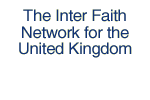|
The Warwick Religions and Education Research Unit (University of Warwick) is undertaking a review of resources used in schools to teach world religions. This project is part of the DCSF's RE Action Plan.
 
PROJECT OUTLINETITLE MATERIALS USED IN SCHOOLS TO TEACH WORLD RELIGIONS SPONSOR: Department for Children, Schools and Families (DCSF)
INTRODUCTION
The starting point of this project is an acknowledgement of the commitment made in all sectors of school education (maintained, independent, voluntary aided, academies) to the promotion of community cohesion, and tolerance and harmony between different cultural traditions. The project is building on this by working with schools across England to find out what materials are available for use in religious education classes, and to assess their potential for creating greater understanding of religion, beliefs and religious diversity in a plural society. It is bringing together for the first time perspectives on, and experiences of, religious education from maintained schools, independent schools and schools with a religious character.
AIMS
In relation to maintained and independent, primary and secondary schools in England, the aims of the project are to: examine the materials available to schools for teaching and learning about and from the principal religions in England, to support community cohesion and promote religious understanding amongst pupils. explore which materials are commonly used by schools, what key factors schools consider when selecting materials, and how those materials are used in class identify any improvements that can be made to materials to enable a fuller understanding of the different religions and beliefs in our society and support community cohesion. The research will indicate whether there is consensus about what makes an effective RE resource, and if so, whether it is possible to draw out generic criteria to help schools decide which materials would be the most useful for their particular religious education needs
RESEARCH DESIGN AND METHODS
The project uses both quantitative and qualitative methods and is divided into three inter-related strands. Strand 1 – a review of available materials i. A sample of published materials is being reviewed by a panel of experts consisting of members of faith groups, academic experts and professional RE experts.
ii. The panel will review materials identified in Strands 2 and 3 as those that are most widely used by schools.
iii. The reports from the panel of experts will be analysed in order to make recommendations.
Strand 2 - a quantitative Survey of materials used in schools i. A self-completion questionnaire is being sent out to RE subject leaders in schools of all types selected randomly within each category. ii. Subject leaders are asked to identify materials which are used by: teachers in the preparation of lessons, including those for personal instruction; teachers and by students during lessons; students during their own independent researches.
Strand 3 - qualitative Case Studies i.Qualitative case studies are being conducted in 10 primary and 10 secondary schools, selected from maintained and independent schools of all types, in order to provide more detailed information on the use and reception of materials in the classroom and examples of good practice ii.The case study visits to schools include the following activities: Document analysis (e.g. the RE syllabus used by the school) Lesson observations (e.g. to see how materials are used) Semi-structured interviews (e.g. with the subject leader, head teachers and pupils) Focus groups (pupils).
Throughout the project there will be ongoing consultation between the research groups involved in the three strands, the schools involved in the case studies and the experts from the different faith communities. PROPOSED TIME SCALE
July 2008 – October 2009 PROJECT OUTCOMES
Project updates will be produced for the DCSF, and a final report is due to be published in December 2009. CONTACT DETAILS Professor Robert Jackson
Warwick Religions and Education Research Unit
Institute of Education
University of Warwick
CV4 7AL
|

 Review of Resources
Review of Resources  Review of RE Resources
Review of RE Resources  Review of RE Resources
Review of RE Resources





